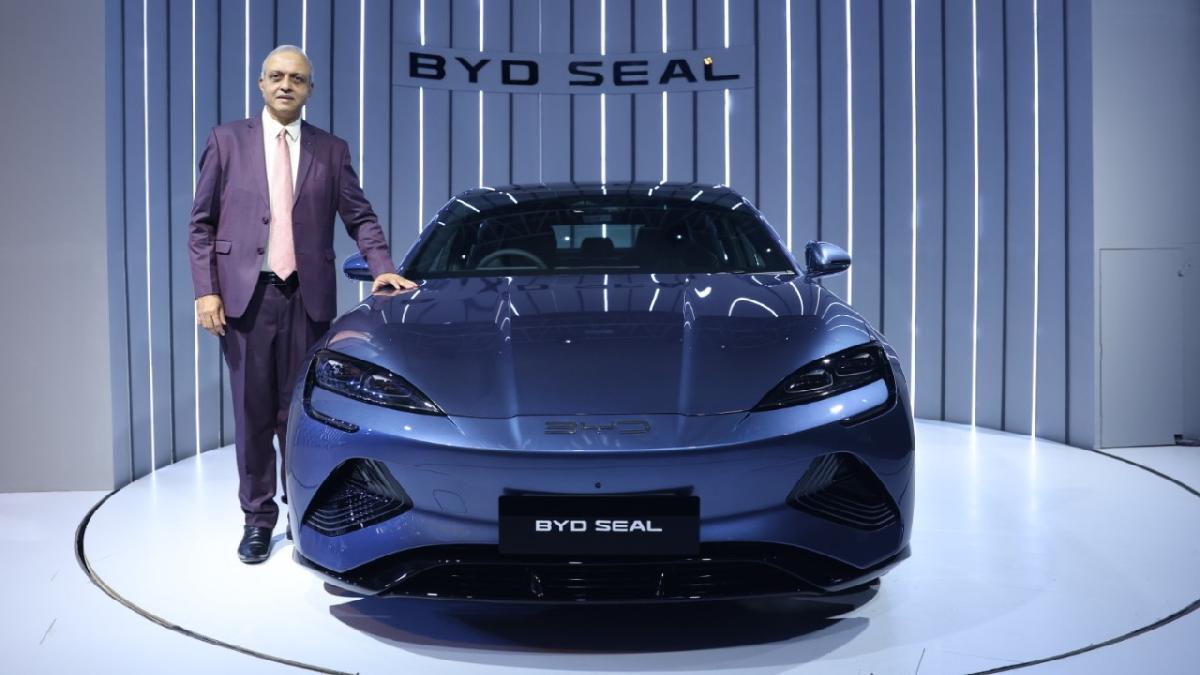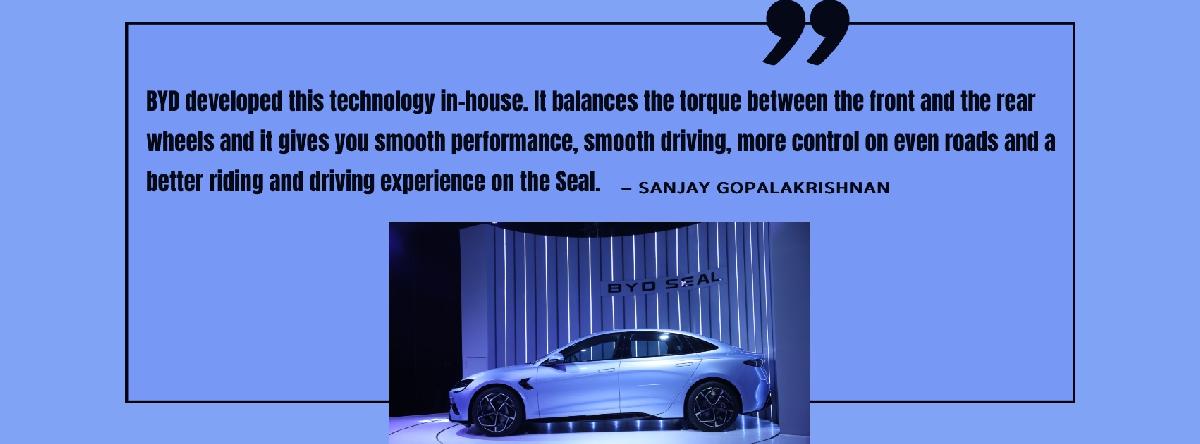
By : RACHNA TYAGI
NEW DELHI :
At the launch of BYD Seal, TURN OF SPEED caught up with Sanjay Gopalakrishnan, Senior Vice President, Electric Passenger Vehicle Business, BYD India, where he waxed eloquent on their latest tech-based offering and gave us an insight into the technology-based innovation company that has battery at its core. Excerpts from the interview…
TOS: What according to you is the USP of the BYD Seal?
SG: The biggest USP of the BYD Seal is the Cell to Body technology which BYD first introduced. What we do is [that] we integrate the battery into the body chassis so it gives a very thin structure and bigger space while giving strength and flexibility to the car. It also gives enhanced safety and enhanced rigidity and the side impact and the frontal impact almost reduces by 20-40% in terms of the vehicle. I think that is the biggest advantage of the BYD Seal. In the Atto 3 we have the e-platform 3.0 and the Blade battery as a pack. In the BYD Seal it is one piece and so, you will not see a separate battery compartment. Integrating the battery into the body chassis [has resulted in] weight reduction by almost by 10%, a flat floor, and three people can easily sit behind. That is the advantage. Also, globally, everybody calls it a Model 3 competitor, that is the second biggest advantage we have for the BYD Seal.
TOS: Do you plan on building the BYD Seal in India?
SG: No, currently we don’t have any plans. We will import it. We will see how the demand goes and accordingly we’ll bring our solutions.
TOS: What has the response to your other vehicles, the E6 and Atto 3, been like in India?
SG: We operate in the e-mpv segment and the e-SUV segment. We are in the 30 Lakh + price bracket, so in that price bracket of EVs we are the market leaders for last year and the response has been good. I think the reason the customer response has been good is because of the very little difference in the theoretical range and the practical range which BYD offers. I think that is the biggest advantage we have and of course, coupled with Blade battery and the technology. Plus, we are a born EV platform, it is not converted from an ICE to an EV which means the performance, the ride quality [and] everything is as per EV standards, that is what the consumers are liking. That is why we have been accepted as an EV car manufacturer or car seller in the country.
TOS: What are the other battery technologies that BYD is currently working on?
SG: Blade battery is the Lithium-Ion phosphate-free Blade battery technology. Globally, we have announced something on Sodium-Ion Batteries for electric cars also.Globally, that is what is happening. But we have just announced that and it is too early to say… maybe, sometime down the year, in some of the global models, we’ll be trying that out.

TOS: What in your opinion is the Indian EV consumer like and what does he expect?
SG: You can say that the initial set of EV consumers for any EV is going to be evolved because he is not going to be a first-time buyer, he is most likely going to be a second time buyer. Probably in the mass segment… it has just come in, maybe, he could be a first-time buyer but even in a product like MG Comet, it could be [a] second time, third time buyer [looking for] just a car for a small family, a runabout. He would have bigger cars. He’s not a first-time buyer, even though the price is INR 6-8 Lakhs. Instead of buying an e-2W, he’s buying a small car. So, the EV consumer, at least what we feel, is evolved and is a second car or a replacement car buyer. Some of the important things that he looks at is how the performance is, what the range is and so, depending on that, he will choose the car [for] small city driving, or a bigger city or regular driving, so, I think that is the most important part. Rest, I think yes, if people are worried about technology, they will worry about the cars that are available and what technology do they need. People are well-educated, have travelled abroad and they know about various other technologies that exist. But I think, in India, we still have all ICE converted into EVs except BYD which is a pure EV. So, I think in another 3-4 years you will have more of pure EVs coming, then we’ll see how people are adapting to that. But I think for us, what we have seen at BYD is that most of them are second time, third time car owners because we are in a particular segment. So, I think they’re already own luxury cars, big SUVs and they want to get a second car in the family – an EV or they want to [make that] transition from a big ICE [vehicle] to a new EV, that’s how we’ve found the consumers to be. Yes, they’re demanding and they feel that EV means features, and of course, at that particular price point they expect all the features to be there.
TOS: Tell us about your phenomenal I-TAC technology…
SG: BYD developed this technology in-house.

It balances the torque between the front and the rear wheels and it gives you smooth performance, smooth driving, more control on even roads and a better riding and driving experience on the Seal. BYD develops all technologies in-house, whether it is batteries, motors, electric controllers, chips, semi-conductors, everything is made in-house, so we have forward as well as backward integration.
TOS: How many units are you planning to sell?
SG: Currently, it will be imported and it will be under the ECE certificate and depending upon the demand… we’ll see how it goes. Today we have started the official bookings. There have been a lot of inquiries because we unveiled the car during the Auto Expo so we’ll see how the demand comes. The cars are at the dealerships already, we’ll see the testdrives happening because [people] will have to take a testdrive. Normally, in EV, consumers want a testdrive to feel it, see it, touch it, so we’ll see how the demand is.
TOS: What are your expansion plans?
SG: Currently we have 24 touchpoints across India. What we want to do is that we want to see how we cover the country. Normally, in the auto industry what we see is we cover 90% of the EV market which means we are there in most of the cities that is what we are trying to do this year. So, let us cover 90% of the EV market which means we will cover major cities, Tier I towns, 10 touch points, 20 touchpoints… we’ll see how it goes… but atleast we’ll cover where the consumer is, where the market is there. We don’t want to be where the market is not there, so with existing dealers, with new partners we’ll see how to expand that as per our plans.
TOS: Where have most of the sales for BYD vehicles come from?
SG: South region… Bangalore, Hyderabad, Kerala and Chennai.
TOS: Where most people live in independent homes and thereby find charging easier…
SG: Absolutely right.
